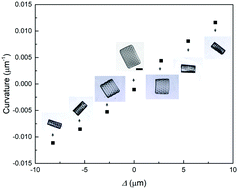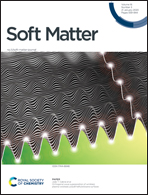Simultaneous control of Gaussian curvature and buckling direction by swelling of asymmetric trilayer hydrogel hybrids†
Abstract
Trilayer polymer films consisting of a thermoresponsive hydrogel, poly(diethyl acrylamide) (PDEAM), sandwiched by rigid layers of a glassy polymer, poly(para-methylstyrene) (PpMS), patterned into parallel striped features are prepared and used to drive temperature-responsive reversible anisotropic expansion. Significant swelling occurs along the direction perpendicular to the stripes, while very little swelling is observed along the direction parallel to the stripes, leading to an overall swelling anisotropy of 1.17. Introducing a difference Δ in the widths of the stripes on the top to bottom surfaces causes the films to roll upon swelling, where both the magnitude and sign of the resulting curvature can be controlled by varying Δ. Using patterns of concentric circular lines (analogous to +1 defects in liquid crystalline polymers), we demonstrate the swelling-induced formation of cone-like shapes, where the buckling direction of each unit can be programmed through local variations in Δ. This trilayer concept provides a simple way to simultaneously control both the Gaussian curvature and direction of buckling in shape-morphing hydrogels, with advantages for accessing smaller length-scales compared to existing methods.



 Please wait while we load your content...
Please wait while we load your content...